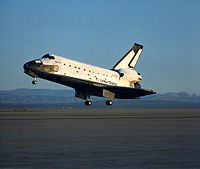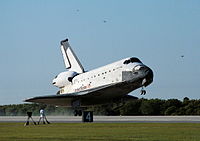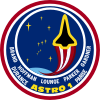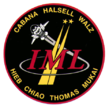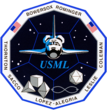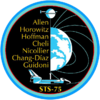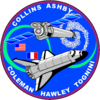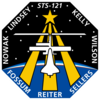- Space Shuttle Columbia
-
Columbia
OV-102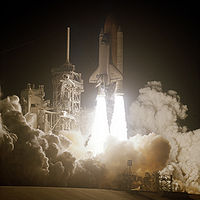
Space Shuttle Columbia launches on STS-109(HST-3B)to repair the Hubble Space telescope.This was the final sucessful mission of Columbia before STS-107OV designation OV-102 Country United States Contract award July 26, 1972 Named after Columbia (1773)
(renamed Columbia Rediviva, 1787)Status Destroyed February 1, 2003 First flight STS-1
April 12, 1981 – April 14, 1981Last flight STS-107
January 16, 2003 – February 1, 2003Number of missions 28 Crews 160 Time spent in space 300 days 17:40:22[1] Number of orbits 4,808 Distance travelled 201,497,772 km (125,204,911 miles) Satellites deployed 8 Space Shuttle Columbia (NASA Orbiter Vehicle Designation: OV-102) was the first spaceworthy Space Shuttle in NASA's orbital fleet. First launched on the STS-1 mission, the first of the Space Shuttle program, it completed 27 missions before being destroyed during re-entry on February 1, 2003 near the end of its 28th, STS-107. All seven crew members were killed. Following an independent investigation into the cause of the accident, President Bush decided to retire the Shuttle orbiter fleet in 2010 in favor of the Constellation program and its manned Orion spacecraft. However, President Obama signed the NASA Authorization Act of 2010 on October 11 which officially brought the Constellation program to an end.
Contents
History
Construction began on Columbia in 1975 at Rockwell International's (formerly North American Aviation/North American Rockwell, now Boeing North America) principal assembly facility in Palmdale, California, a suburb of Los Angeles. Columbia was named after the American sloop Columbia Rediviva which, from 1787 to 1793, under the command of Captain Robert Gray, explored the US Pacific Northwest and became the first American vessel to circumnavigate the globe. It is also named after the Command Module of Apollo 11, the first manned landing on another celestial body.[2] Also, in Jules Verne's 1865 novel From the Earth to the Moon, the moonshot is accomplished by firing the spacecraft from a giant cannon in Florida called a columbiad. After construction, the orbiter arrived at Kennedy Space Center on March 25, 1979, to prepare for its first launch. Columbia was originally scheduled to lift off in late 1979, however the launch date was delayed by problems with both the SSME components, as well as the thermal protection system (TPS).[3] On March 19, 1981, during preparations for a ground test, workers were asphyxiated while working in Columbia's nitrogen-purged aft engine compartment, resulting in (variously reported) two or three fatalities.[4][5]
The first flight of Columbia (STS-1) was commanded by John Young, a Gemini and Apollo veteran who was the ninth person to walk on the Moon in 1972, and piloted by Robert Crippen, a rookie astronaut originally selected to fly on the military's Manned Orbital Laboratory (MOL) spacecraft, but transferred to NASA after its cancellation, and served as a support crew member for the Skylab and Apollo-Soyuz missions.
Columbia spent 610 days in the Orbiter Processing Facility (OPF), another thirty-five days in the Vehicle Assembly Building (VAB), and 105 days on Pad 39A before finally lifting off.[3] Columbia was successfully launched on April 12, 1981, the 20th anniversary of the first human spaceflight (Vostok 1), and returned on April 14, 1981, after orbiting the Earth 36 times, landing on the dry lakebed runway at Edwards Air Force Base in California. Columbia then undertook three further research missions to test its technical characteristics and performance. Its first operational mission, with a four-man crew, was STS-5, which launched on November 11, 1982. At this point Columbia was joined by Challenger, which performed the next three shuttle missions, while Columbia underwent modifications for the first Spacelab mission.
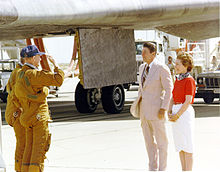 Columbia astronauts Thomas K. Mattingly and Pilot Henry Hartsfield salute President Ronald Reagan, standing beside his wife, Nancy, upon landing in 1982.
Columbia astronauts Thomas K. Mattingly and Pilot Henry Hartsfield salute President Ronald Reagan, standing beside his wife, Nancy, upon landing in 1982.
In 1983, Columbia, under the command of John Young for his sixth spaceflight, undertook its second operational mission (STS-9), in which the Spacelab science laboratory and a six-person crew was carried, including the first non-American astronaut on a space shuttle, Ulf Merbold. After the flight, Columbia spent the next three years at the Rockwell Palmdale facility, undergoing modifications that removed the Orbiter Test Flight hardware and bringing it up to similar specifications as that of its sister Orbiters. At that time the shuttle fleet was expanded to include Discovery and Atlantis.
Columbia returned to space on January 12, 1986, with the launch of STS-61-C. The mission's crew included Dr. Franklin Chang-Diaz, as well as the first sitting member of the House of Representatives to venture into space, Bill Nelson.
The next shuttle mission was undertaken by Challenger. It was launched on January 28, 1986, ten days after STS-61-C had landed. The mission ended in disaster 73 seconds after launch. In the aftermath NASA's shuttle timetable was disrupted, and Columbia was not flown again until 1989 (on STS-28), after which it resumed normal service as part of the shuttle fleet.
STS-93, launched on July 23, 1999, was commanded by Lt. Col. Eileen Collins, the first female Commander of a U.S. spacecraft.
Prototype orbiter
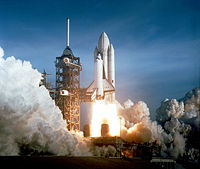 Columbia launching during STS-1. Its distinctive black chines and "USA" painted on the starboard wing are visible. Columbia was the only orbiter launched with its external tank painted white, which was later discontinued to save weight.
Columbia launching during STS-1. Its distinctive black chines and "USA" painted on the starboard wing are visible. Columbia was the only orbiter launched with its external tank painted white, which was later discontinued to save weight.
As the second orbiter to be constructed, yet the first able to fly into space, Columbia was roughly 8,000 lb (3,600 kg) heavier than subsequent orbiters such as Endeavour, which were of a slightly different design, and had benefited from advances in materials technology.[6] In part, this was due to heavier wing and fuselage spars, the weight of early test instrumentation that remained fitted to the avionics suite, and an internal airlock that, originally fitted into the other orbiters, was later removed in favor of an external airlock to facilitate Shuttle/Mir and Shuttle/International Space Station dockings.[7] This retention of an internal airlock allowed NASA to use Columbia for the STS-109 Hubble Space Telescope servicing mission, along with the Spacehab double module used on STS-107. Due to Columbia's heavier weight, it was less ideal for NASA to use it for missions to the International Space Station, though modifications were made to the Shuttle during its last refit in case the spacecraft was needed for such tasks.
Externally, Columbia was the first orbiter in the fleet whose surface was mostly covered with High & Low Temperature Reusable Surface Insulation (HRSI/LRSI) tiles as its main thermal protection system (TPS), with white silicone rubber-painted Nomex — known as Felt Reusable Surface Insulation (FRSI) blankets — in some areas on the wings, fuselage and Payload Bay Doors. FSRI once covered almost 25% of the orbiter, though the first upgrade resulted in its removal from many areas, and in later flights was only used on the upper section of the Payload Bay Doors and inboard sections of the upper wing surfaces.[8] The upgrade also involved replacing many of the white LRSI tiles on the upper surfaces with Advanced Flexible Reusable Surface Insulation (AFRSI) blankets (also known as Fibrous Insulation Blankets, or FIB's) after their successful use on shuttle Discovery and Atlantis. Originally, Columbia had 32,000 tiles — the upgrade reduced this to 24,300. The AFRSI blankets consist of layers of pure silica felt sandwiched between a layer of silica fabric on the outside and S-Glass fabric on the inside, stitched together using pure silica thread in a 1-inch grid, then coated with a high-purity silica coating. The blankets are semi-rigid and can be made as large as 30" by 30". Each blanket can replace as many as 25 tiles and is bonded directly to the orbiter.[8] The direct application of the blankets to the orbiter results in weight reduction, improved producibility and durability, reduced fabrication and installation cost, and reduced installation schedule time.[9] The work was performed during Columbia's first retrofitting and the post-Challenger stand-down.
Despite refinements to the launcher's thermal protection system and other enhancements, Columbia would never weigh as little unloaded as the other orbiters in the fleet. The next-oldest shuttle, Challenger, was also relatively heavy, although 2,200 lb (1,000 kg) lighter than Columbia.
Until its last refit, Columbia was the only operational orbiter with wing markings consisting of an American flag on the port (left) wing and the letters "USA" on the starboard (right) wing. Challenger, Discovery, Atlantis, Endeavour, and even the Enterprise all, until 1998, bore markings consisting of the letters "USA" afore an American flag on the left wing, and the pre-1998 NASA "worm" logo afore the respective orbiter's name on the right wing. From its last refit to its destruction, Columbia bore markings identical to those of its operational sister orbiters — the NASA "meatball" logo on the left wing and the American flag afore the orbiter's name on the right; only Columbia's distinctive wing "chines" remained. These black areas on the upper surfaces of the shuttle's forward wing were added because, at first, shuttle designers did not know how reentry heating would affect the craft's upper wing surfaces. The "chines" allowed Columbia to be easily recognized at a distance, as opposed to the subsequent orbiters.
Another unique external feature, termed the "SILTS" pod, was located on the top of Columbia's tailfin, and was installed after STS-9 to acquire infrared and other thermal data. Though the pod's equipment was removed after initial tests, NASA decided to leave it in place, mainly to save costs, along with the agency's plans to use it for future experiments. The tailfin was later modified to incorporate the drag chute first used on Endeavour in 1992.
Columbia was also originally fitted with Lockheed Martin-built ejection seats identical to those found on the SR-71 Blackbird. These were active for the four orbital test flights, but deactivated after STS-4, and removed entirely after STS-9. Columbia was also the only orbiter not delivered with head-up displays for the Commander and Pilot, although these were incorporated after STS-9. Like its sister ships, Columbia was eventually retrofitted (at its last refit) with the new MEDS "glass cockpit" display and lightweight seats.
Had Columbia not been destroyed, it would have been fitted with the external airlock/docking adapter for STS-118, an International Space Station assembly mission, originally planned for November 2003. Columbia was scheduled for this mission due to Discovery being out of service for its Orbital Maintenance Down Period, and because the ISS assembly schedule could not be adhered to with only Endeavour and Atlantis.
Columbia’s career would have started to wind down after STS-118. It was to service the Hubble Space Telescope two more times, once in 2004, and again in 2005, but no more missions were planned for it again until 2009 when, on STS-144, it would retrieve the Hubble Space Telescope from orbit and bring it back to Earth. Following the Columbia accident, NASA flew the STS-125 mission using Atlantis, combining the planned fourth and fifth servicing missions into one final visit to Hubble. Because of the expected retirement of the Space Shuttle fleet, the batteries and gyroscopes that keep the telescope pointed will eventually fail, which would result in its reentry and break-up in Earth's atmosphere. A "Soft Capture Docking Mechanism", based on the docking adapter that was to be used on the Orion spacecraft, was installed during the last servicing mission in anticipation of this event.
Columbia was also scheduled to launch the X-38 V-201 Crew Return Vehicle prototype as the next mission after STS-118, until the cancellation of the project in 2002.
Flights
Space Shuttle Columbia flew 28 flights, spent 300.74 days in space, completed 4,808 orbits, and flew 125,204,911 miles (201,497,772 km) in total, including its final mission.
Columbia was the only shuttle to have been spaceworthy during the Shuttle-Mir and International Space Station programs and yet to have never visited either Mir or ISS. In contrast, Discovery, Atlantis, and Endeavour have all visited both stations at least once, as Columbia was not suited for high-inclination missions. Challenger was destroyed before the Shuttle-Mir Program began, and Enterprise never flew in space.
# Date Designation Launch pad Landing location Notes 1 1981, April 12 STS-1 39-A Edwards Air Force Base First shuttle mission. Launch witnessed by the band Rush; inspired the song "Countdown" on their 1982 album Signals. 2 1981, November 12 STS-2 39-A Edwards Air Force Base First re-use of manned space vehicle 3 1982, March 22 STS-3 39-A White Sands Space Harbor First mission with an unpainted External tank.
Only time that a space shuttle has landed at the White Sands Space Harbor. This launch was dedicated by Ronald Reagan to "the people of Afghanistan".4 1982, June 27 STS-4 39-A Edwards Air Force Base Last shuttle R&D flight 5 1982, November 11 STS-5 39-A Edwards Air Force Base First four-person crew, first deployment of commercial satellite. 6 1983 November 28 STS-9 39-A Edwards Air Force Base First six-person crew, first Spacelab. 7 1986, January 12 STS-61-C 39-A Edwards Air Force Base Representative Bill Nelson (D-FL) on board/ final successful shuttle flight before Challenger disaster 8 1989, August 8 STS-28 39-B Edwards Air Force Base Launched KH-11 reconnaissance satellite 9 1990, January 9 STS-32 39-A Edwards Air Force Base Retrieved Long Duration Exposure Facility 10 1990, December 2 STS-35 39-B Edwards Air Force Base Carried multiple X-ray & UV telescopes 11 1991, June 5 STS-40 39-B Edwards Air Force Base 5th Spacelab – Life Sciences-1 12 1992, June 25 STS-50 39-A Kennedy Space Center U.S. Microgravity Laboratory 1 (USML-1) 13 1992, October 22 STS-52 39-B Kennedy Space Center Deployed Laser Geodynamic Satellite II 14 1993, April 26 STS-55 39-A Edwards Air Force Base German Spacelab D-2 Microgravity Research 15 1993, October 18 STS-58 39-B Edwards Air Force Base Spacelab Life Sciences 16 1994, March 4 STS-62 39-B Kennedy Space Center United States Microgravity Payload-2 (USMP-2) 17 1994, July 8 STS-65 39-A Kennedy Space Center International Microgravity Laboratory (IML-2) 18 1995, October 20 STS-73 39-B Kennedy Space Center United States Microgravity Laboratory (USML-2) 19 1996, February 22 STS-75 39-B Kennedy Space Center Tethered Satellite System Reflight (TSS-1R) 20 1996, June 20 STS-78 39-B Kennedy Space Center Life and Microgravity Spacelab (LMS) 21 1996, November 19 STS-80 39-B Kennedy Space Center 3rd flight of Wake Shield Facility (WSF)/ longest Shuttle flight 22 1997, April 4 STS-83 39-A Kennedy Space Center Microgravity Science Laboratory (MSL)- cut short 23 1997, July 1 STS-94 39-A Kennedy Space Center Microgravity Science Laboratory (MSL)- reflight 24 1997, November 19 STS-87 39-B Kennedy Space Center United States Microgravity Payload (USMP-4) 25 1998, April 13 STS-90 39-B Kennedy Space Center Neurolab – Spacelab 26 1999, July 23 STS-93 39-B Kennedy Space Center Deployed Chandra X-ray Observatory 27 2002, March 1 STS-109 39-A Kennedy Space Center Hubble Space Telescope service mission (HSM-3B) 28 2003, January 16 STS-107 39-A Did not land (Planned to land at Kennedy Space Center) A multi-disciplinary microgravity and Earth science research mission. Shuttle destroyed during re-entry on February 1, 2003 and all seven astronauts on board died. Mission insignia
Mission insignia for Columbia flights STS-1 STS-2 STS-3 STS-4 STS-5 STS 9 STS-61-C STS-28 STS-32 STS-35 STS-40 STS-50 STS-52 STS-55 STS-58 STS-62 STS-65 STS-73 STS-75 STS-78 STS-80 STS-83 STS-94 STS-87 STS-90 STS-93 STS-109 STS-107 STS-118 (Mission flown by Endeavour due to loss. See STS-107) STS-121 (Mission flown by Discovery due to loss. See STS-107) Final mission and destruction
Columbia was destroyed at about 0900 EST on February 1, 2003 while re-entering the atmosphere after a 16-day scientific mission. The Columbia Accident Investigation Board determined that a hole was punctured in the leading edge on one of Columbia's wings, made of a carbon-carbon composite. The hole had formed when a piece of insulating foam from the external fuel tank peeled off during the launch 16 days earlier and struck the shuttle's wing. During the intense heat of re-entry, hot gases penetrated the interior of the wing, destroying the support structure and causing the rest of the shuttle to break apart. The nearly 84,000 pieces of collected debris of the vessel are stored in a 16th floor office suite in the Vehicle Assembly Building at the Kennedy Space Center. The collection was opened to the media once and has since been open only to researchers.[10][11] Unlike Space Shuttle Challenger, which had a replacement orbiter built, Columbia did not have a replacement orbiter built.
Tribute
Although the debris field encompassed hundreds of miles across North East Texas and into Louisiana, the nose cone and remains of all seven crew members were found in the East Texas community of Sabine County. The residents of Sabine County, and the City of Hemphill where the recovery efforts were centered, as well as countless volunteers who participated in the recovery operation were forever marked by the experience. To honor those who lost their lives aboard the shuttle and during the recovery, The Patricia Huffman Smith Museum; Remembering Columbia, has been opened in Hemphill, Texas. The museum tells the story of space exploration from the first mission of the Columbia to its last mission, STS-107. It also reveals the efforts of local citizens during the recovery of Space Shuttle Columbia, STS-107 and its Crew. An area is dedicated to each crewmember that was lost in the tragedy, including the Texas Forest Service employee and the helicopter pilot who lost their lives during the recovery effort. The families of the crew have contributed personal items belonging to their loved ones for permanent display. The museum houses many items and artifacts from NASA and its contractors, the families of STS-107, as well as from other individuals. The museum will feature two simulator interactive devices that emulate activities of the shuttle and orbiter. The classroom for the digital learning center will provide an excellent opportunity for the advancement of education for people of all ages.
The shuttle's final crew was honored in 2003 when the USGS's Board of Geographic Names approved the name Columbia Point for a 13,980-foot (4,260 m) mountain in Colorado's Sangre de Cristo Mountains, less than a half-mile from Challenger Point, a peak named after America's other lost shuttle. The Columbia Hills on Mars were also named in honor of the crew, and a host of other memorials were dedicated in various forms.
Fans of the original Star Trek television series were largely responsible for NASA naming the first Space Shuttle Enterprise. In the television series Star Trek: Enterprise both the first and second starships of the human-built NX-Class, registry numbers NX-01 & NX-02 respectively, were named in honor of pre-existing NASA space shuttles. The second vessel's name was first revealed in the season 3 episode "E²" to be Columbia, in honor of the space shuttle Columbia following its destruction on February 1, 2003. Uniforms on NX-02 Columbia bear a crew patch depicting 7 stars, in honor of the astronauts who died in the shuttle accident.
The space shuttle Columbia makes a cameo role in the 1998 Japanese anime Cowboy Bebop episode "Wild Horses". Coincidentally, it crashes after re-entry (though without burning up) due to the heat resistant tiles peeling off.
The Deep Purple song "Contact Lost" on their 2003 album Bananas was dedicated to, and written for, the astronauts whose lives were lost in the 2003 shuttle disaster. Astronaut Kalpana Chawla, one of the victims of the crash, took three CDs into space with her, two of which were Deep Purple albums (Machine Head and Purpendicular). Both CDs survived both the shuttle destruction and the 39-mile plunge.[12] Chawla also traded e-mails with the band while in space, making the tragedy even more personal for the group.[13]
The musical group Echo's Children included singer-songwriter Cat Faber's "Columbia" on their final album "From the Hazel Tree." [14]
The Long Winters 2005 Album "Ultimatum" features the song "The Commander Thinks Aloud", a tribute to the final Columbia crew. [15]
See also
- Columbia disaster
- List of human spaceflights
- List of Space Shuttle crews
- List of space shuttle missions
- Timeline of Space Shuttle missions
References
- ^ Harwood, William (October 12, 2009). "STS-129/ISS-ULF3 Quick-Look Data". CBS News. http://www.cbsnews.com/network/news/space/129/129quicklook2.pdf. Retrieved November 30, 2009.
- ^ http://www-pao.ksc.nasa.gov/shuttle/resources/orbiters/Columbia.html
- ^ a b Slovinac, Patricia; Deming, Joan. "Avionics Systems Laboratory/Building 16. Historical Documentation". NASA Technical Reports Server. NASA. http://hdl.handle.net/2060/20110002109. Retrieved 18 October 2011.
- ^ "March 19, 1981: Shuttle Columbia's First Fatalities". Wired News. March 19, 2009. http://www.wired.com/science/discoveries/news/2009/03/dayintech_0319. Retrieved July 29, 2009.
- ^ "Space shuttle worker dies in fall at launch pad". MSNBC. March 14, 2011. http://www.msnbc.msn.com/id/42072452/ns/technology_and_science-space/. Retrieved August 2, 2011.
- ^ "Orbiter Overhaul: The Columbia weight loss plan". Spaceflight Now. April 14, 2000. http://spaceflightnow.com/shuttle/features/000414overhaul/weightloss.html. Retrieved July 17, 2009.
- ^ "Orbiter Overhaul: Flying into the future". Spaceflight Now. April 14, 2000. http://spaceflightnow.com/shuttle/features/000414overhaul/future.html. Retrieved July 17, 2009.
- ^ a b [www-pao.ksc.nasa.gov/kscpao/nasafact/pdf/TPS-06rev.pdf "Orbiter Thermal Protection System PDF Document"]. NASA's Kennedy Space Center Public Affairs Office. 2006. www-pao.ksc.nasa.gov/kscpao/nasafact/pdf/TPS-06rev.pdf. Retrieved June 7, 2011.
- ^ "Advanced Flexible Reusable Surface Insulation Blankets". NASA. April 7, 2002. http://spaceflight.nasa.gov/shuttle/reference/shutref/orbiter/tps/blankets.html. Retrieved June 7, 2011.
- ^ "Shuttle Columbia's wreckage finds final resting place". New York Times. February 8, 2004. http://www.redorbit.com/news/space/46632/shuttle_columbias_wreckage_finds_final_resting_place/index.html. Retrieved May 2, 2010.
- ^ "Columbia's Arlington". Collect Space. February 1, 2004. http://www.collectspace.com/news/news-020104a.html.
- ^ http://blogcritics.org/music/article/down-to-earth-deep-purple-cds/
- ^ http://www.webcitation.org/5MfMKfRYt
- ^ http://www.echoschildren.org/CDlyrics/Columbia.html
- ^ http://5by5.tv/b2w/31
 This article incorporates public domain material from websites or documents of the National Aeronautics and Space Administration.
This article incorporates public domain material from websites or documents of the National Aeronautics and Space Administration.External links
- Last interview of Columbia crew and memorial service with eulogy by singer Patti LaBelle (Google Video)
- Maiden launch of Columbia (Google Video)
- Columbia accident investigation board
- Columbia Crew Survival Investigation Report
- Columbia Loss FAQ, compiled by members of usenet newsgroups sci.space.history and sci.space.shuttle, including some employees of NASA and their respective contractor agencies. Much of the FAQ content has been copied and used by many of the news services without credit given, including Florida Today and Space.com.
- Space.com Columbia FAQ.
- Shuttle Orbiter Columbia (OV-102)
- New York Times coverage of the shuttle
- Space Mirror Memorial
- Mission Summary Archive
- Columbia accident in the Newseum archive of front page images from 2003-02-02.
- Space Shuttle Memorial covering both space shuttle disasters
STS-107 
Main articles Space Shuttle Columbia · Space Shuttle Columbia disaster · Space Shuttle external tank · Space Shuttle thermal protection system
Crew See also Columbia Accident Investigation Board · SpaceHab · FREESTAR · Hitchhiker · Extended Duration OrbiterSpace Shuttle Columbia (OV-102) Flights Status See also NASA Space Shuttle (STS) Core topics 


Components Orbiters Add-ons Sites Operations Missions (cancelled) · Crews · Mission timeline · rollbacks · Abort modes · Rendezvous pitch maneuverTesting Disasters Support Special Derivatives Related Space Shuttle design process · Inertial Upper Stage · Payload Assist Module · ISS · Space Shuttle retirement · Explorer (shuttle replica)Space Shuttles  United States Space Shuttle program
United States Space Shuttle program Soviet Buran program
Soviet Buran program- Pathfinder (OV-098, ground tests)
- Enterprise (OV-101, atmospheric tests, retired)
- Columbia (OV-102, destroyed 2003)
- Challenger (OV-099, destroyed 1986)
- Discovery (OV-103, retired)
- Atlantis (OV-104, retired)
- Endeavour (OV-105, retired)
Categories:- Manned spacecraft
- Space Shuttles
Wikimedia Foundation. 2010.

